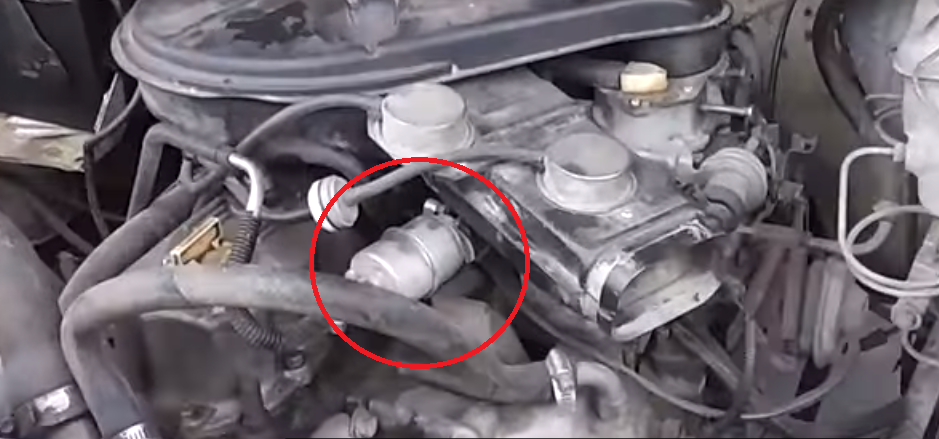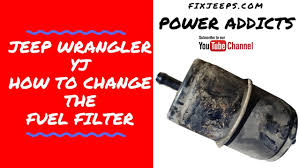Jeep Wrangler YJ Fuel Filter
Changing a Jeep Wrangler YJ fuel filter isn't hard. Typically it is just a couple of hose clamps to loosen to remove the filter. Install the new filter and tighten the clamps. Filter is changed!!
Where it is located depends on what model Jeep Wrangler you have. If you have a fuel injected Wrangler like both of mine. The fuel filter is located under the Jeep by the drivers side rear tire. It can and often does have a metal band holding it in place. You can reference this YouTube video (<-- Click the link) to see what I'm talking about.
If you have an older model Wrangler that has a carburetor, the fuel filter is going to be inline up close to the carburetor as you see circled in red in the picture below. If it is the factory original set up there are 3 hose clamps to loosen on those. There is the possibility of having only 2 clamps so keep that in mind if your fuel system is a different.

Jeep Wrangler YJ Fuel Filter - How often should it be changed?
This answer varies all over the place! There are service manuals that recommend every 30,000 miles. The YJ Service Manual says 60,000 miles. There are some that say you never have to change them. I do not agree with any of these service intervals. I DO change all the filters on every vehicle I own.
The Jeep Wrangler YJ Fuel filters are not expensive at all. I daily drive my 1991 Jeep Wrangler 4.0 so I recommend changing the fuel filter about every 3rd oil change. You can change it more or less depending on your habits, drive mileage or even the quality of the gas in your area.
What are the symptoms of a bad fuel filter?
Lack of engine power
Lets use an analogy to make this easier to understand. Imagine a jogger running down the track. They have their mouth slightly open breathing in oxygen a nice controlled manner getting their exercise in. The oxygen is part of the fuel to the body of the runner.
Now imagine the same jogger trying to run breathing through a drinking straw. The straw is creating a restriction preventing the runner from getting the proper amount of oxygen to run, therefore the runner is running out of energy and strength to keep running.
This analogy can be used for air filters as well.
So this analogy can be a direct comparison to a clogged up fuel filter in a Jeep or any other vehicle for that matter.
When there is a lack of fuel getting to the engine due to a clogged fuel filter the ECM or the engine computer will make adjustments to help prevent the engine from detonating or pinging. This kills engine power from idle to full throttle.
If you have a carburetored engine, the lack of fuel flow can make the engine start pinging sounding like its got a small high pitched rattling sound. Same as a fuel injected engine, it kills that engine horse power.
This rattling sound is known as detonation or pinging as I mentioned above. Each one of those pinging sounds is the fuel/air mixture exploding before its time. Yes this creates that sound, but much worse it takes little tiny fragments of piston or spark plugs with it each time the fuel prematurely explodes.
Engine stalling under strain
Remember the analogy above? Same thang man!! You can't do work if you have no energy. No food .. no oxygen .. no energy.
Your Jeep is going up up a long hill, you press the gas pedal harder to keep your speed. The Jeep doesn't want to maintain its speed no matter how hard you press the pedal.
That clogged fuel filter is restricting the fuel from getting to the engine injectors or carburetor therefore limiting the engines ability to make power.
Often times lack of power under hard acceleration is mistaken as a faulty sensor when in fact is can be a clogged fuel filter.
In many manuals it is said that performing a fuel pressure test can help diagnose a clogged fuel filter. Although this can be true in most instances, the exception to that rule is when the fuel pressure test is only performed at idle. You must perform the fuel pressure test at high idle and mid throttle to see if the fuel pressure starts dropping due to the restriction inside the filter.
Now, much like the explanation of the fuel pressure test, under normal around town driving it may not feel like it is struggling do to the low demand needed.
Randon Engine Misfire
Remember the mentioning above about detonation and pinging. Welp .. when engines start knocking and pinging from a stopped up fuel filter it is due to what is called a lean condition. Lean condition is when the ratio between fuel and air is not correct. There has to be a certain amount of fuel to a given amount of air. When there is not enough fuel that is when you have a lean condition. That lean condition creates the knocks and pings.
Now if that lean condition gets too bad it will start causing misfires, spit and sputtering and those other bad running things.
On a late model fuel injected engine the knock sensor will pull timing out of the engine helping with the bad running. But it will trigger multiple misfire engine codes and still very bad for the engine.
That fuel/air ration thing is a big deal ya know.
What does a Fuel Filter do?
A fuel filter strains dirt and debris from the fuel to prevent it from reaching the engine.
Just to get it out of the way I will mention the one in the tank first. Its known as the fuel pump screen or sock. As the name implies, Its a screen shaped sorta like a sock. It job is to simply prevent larger particles from reaching the main fuel filter.
|
The star of this article is the fuel filter. The main fuel filter uses a pleated paper element encased inside a metal canister with hose attachments at each end. These filters were not designed to be cleaned and reused. |
 |
As mentioned above, depending on what year Jeep Wrangler YJ you own the filter can be located in one of two places.
Jeep Wrangler YJ Fuel Filter
So to summarize this all up.
Up to 1990 the filter will be located under the hood near the carburetor. Years 1991 and up will be just behind the drivers rear wheel.
Change the filter about every 3rd oil change.
Don't buy cheap filters. Stay with quality brands. Oh, DO NOT purchase this POS filters that screw apart with a see through tube center. They are a fire hazard waiting to happen!
Peace out yall!!


